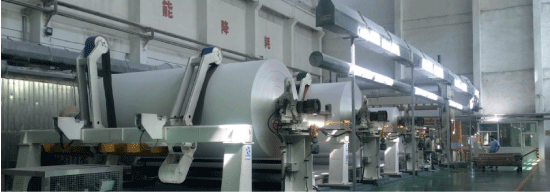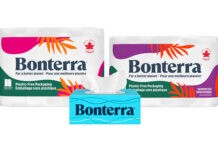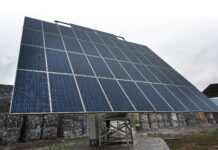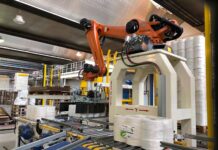Consumer demand – with ‘consumption of household paper set to increase by 6-8%’ – is shifting to medium and high-end tissue, and urbanisation is carrying products into third- and fourth-tier cities and rural markets. TWM talked to Chen Changming, paper manufacturing division general manager, Hengan Group.
TWM/1: What is the current consumption growth of the Chinese tissue market?
“In 2016, China’s consumption was 7.876m tonnes and in 2017 it was 8.501m tonnes, up 8.1%. In 2016, the domestic market was 98.8bn yuan, and in 2017 it was 110.64bn yuan, up 12% year-on-year.
“In 2017, China’s per capita consumption was 6.1kg, much lower than the average American consumption of 21.9kg. In 2016, China’s per capita consumption was 5.7kg, and in 2017 it was 6.1kg, an increase of 7%. It is expected that the per capita consumption growth will be controlled at 6-8% in the next few years. At present, China’s per capita consumption is still low, and the penetration rate of the tissue paper market is low. There is still room for growth. With the country’s economic growth and the liberalisation of the two-child policy, the demand for high-end tissue paper will see a sharp increase. In addition, the elimination of backward production capacity will also bring new production capacity to the market.”
TWM/2: What are your future expectations for tissue paper in the Chinese market?
“The future trend of tissue paper in the sales of its own channels will be mainly based on offline sales, supplemented by E-commerce sales, and a small amount of overseas sales; the proportion of overall sales of E-commerce will increase substantially and the proportion of offline sales will therefore decline. With the elimination of the backward production capacity of the industry and the new paper industry of some enterprises, the number of self-owned brands in supermarkets will increase slightly. In the next few years, the consumption of household paper will increase by about 6-8%. With the impact of economic growth and consumption upgrades, the proportion of toilet paper will continue to decline. The consumption and consumption ratio of products such as liner and kitchen paper will continue to grow.
“In its own channels, with the popularity of the internet and the shift of young consumers’ consumption places (from offline to online), E-commerce sales will become a new consumer battlefield, impacting traditional offline consumption, eroding the line.
“A lower sales share will undermine the traditional offline layout. At the same time, the big data analysis of E-commerce will timely and effectively convey the current market demand, which will help production enterprises flexibly adjust production and comply with market demand.
“With its own brand and with the rapid growth of production capacity, the number of supermarket brands will increase, and the excess capacity will intensify market competition, forcing manufacturers to produce more powerful and better quality products, and accelerate the market in a survival of the fittest.
“In the sanitary paper products sector, the proportion of the traditional bulk toilet paper market will continue to decline in the future. High value-added paper towels, kitchen paper, napkins, facial tissues, etc. will change with economic growth, consumption upgrades and consumer awareness. With substantial growth, the overall market penetration rate will increase. The challenge is that the market’s production capacity is relatively surplus, and the competition in the follow-up market is still fierce.”

TWM/3: What has been the impact of China’s current economy on the tissue market?
“There have been a number of implications. Firstly, household paper is a product with consumption upgrade attributes and its per capita consumption is positively related to per capita GDP. As China’s per capita GDP grows and residents’ spending power increases, it will further promote the release of household paper.
“Secondly, in the context of improving the economic level, people’s quality of life has improved and more emphasis has been placed on cleanliness, health and kitchen hygiene. Consumer demand has diversified and transitioned to medium and high-end products. The market potential is huge (the proportion of facial tissues, paper towels, kitchen papers, etc. has risen, while toilet paper is gradually decreasing).
“Thirdly, with the rapid growth of China’s economy, in an environment of increasing environmental protection requirements and fierce market competition in the country, the pace of elimination of backward production capacity in the tissue paper industry will accelerate, which will further promote the optimisation and upgrading of the industry.
“And then lastly, with the increase of urbanisation in China, medium and high-end products are further popularised in third- and fourth-tier cities and rural markets.”
TWM/4: Are the sales of China’s tissue paper market still dominated by price wars? What are your responses to this situation?
“The price war in the Chinese toilet paper sales market still exists. At present, there is excess capacity of toilet paper, and the average operating rate of the industry is low. Some enterprises will choose low-price promotions to win price wars in order to gain market share.
“In response to this situation, our company has long insisted on quality-based products and does not participate in price wars, but rather we win the market share with quality, brand and good service. The main measures are as follows: 1: As always, maintain the high-quality requirements of Hengan Hearttex and other brands; 2: continue to develop new products such as: Minions, Zhu Pai, bamboo colour paper series; 3: through continuous lean production, energy saving consumption, reduce production costs; 4: efforts to expand overseas markets.”
TWM/5: Describe your current paper business.
“Hengan currently has six tissue paper production bases which are located in Changde, Hunan (production capacity 290,000tpy), Shandong Weifang (315,000tpy), Jinjiang, Fujian (315,000tpy), Chongqing Banan (240,000tpy), Anhui Wuhu (240,000tpy), Xinjiang Changji (50,000tpy). The company’s annual production capacity is 1.45m tonnes.
“The main products of each base are toilet paper, facial tissue, handkerchief paper, kitchen paper, liner paper, etc. Paper towels are mainly produced by Shandong PM2.
“In 2018, our company has brought on-stream two lots of 60,000tpy Valmet paper machines (PM21, PM22); another paper towel machine (3#) is under construction and is expected to be put into production by the end of 2018.”
TWM/6: What are your main business markets?
“Hengan tissue paper supermarket free brand is our leading branded product with Hearttex, Premium, Pinuo, Zhu Pai series. Hengan finished tissues are sold in channels such as supermarkets, hypermarkets and other physical stores, online sales at Taobao, Tmall, Hengan Group official mall and other E-commerce, and overseas sales; the original paper channel sales have domestic special sales and overseas base paper sales.
“Hengan’s tissue paper business includes toilet paper, facial tissue, handkerchief paper, napkin, paper towel, liner paper, kitchen paper, etc. From January to August 2018, the production of toilet and facial tissue accounted for more than 80% of the company’s total, and other items accounted for about 20%. At present, the company mainly produces popular toilet and facial tissues, and continues to promote the sale of high value-added niche raw paper items such as paper towels, liner papers and kitchen papers, and expand the penetration of high value-added items in the market. Our aim is to expand our market share in these sectors.”
TWM/7: Do you produce high-end tissue paper products (specifically TAD/ATMOS products)?
“At present, our company has not produced TAD/ATMOS highendtoilet paper (the company does not currently have TAD/ ATMOS equipment). No related equipment has been introduced in China.”
TWM/8: Do you export household paper products?
“Every year, Hengan has a certain amount of processing and export business. The main destination areas are Australia, America, south east Asia and so on.”
TWM/9: What are your growth expectations for Hengan in the next few years?
“At present, Hengan’s total rated capacity is 1.45m tonnes, and there is still room for improvement in the overall capacity utilisation rate. In the following period, the company will continue to increase its capacity utilisation rate and expand production capacity. If necessary, it will reasonably evaluate the necessity of a new factory and rationally expand production.”
TWM/10: How popular is environmentally friendly household paper in China? Do you produce such products?
“Environmentally-friendly household paper is becoming more and more popular in China. Our four bases in Hunan, Shandong, Wuhu and Chongqing all produce natural paper. At present, the Group has developed a variety of “Bamboo” unbleached tissue and soft coloured paper, the original colour handkerchief paper. Due to the outstanding green and low-carbon properties, our household paper brands, including Hearttex and Zhu Pai, were selected as the recommended products of the World Environmental Protection Conference (WEC).”
TWM/11: Is there any overcapacity in China’s tissue industry?
“At present, China’s overall production capacity is still excessive. The output of the household paper industry increased from 4.78m tonnes in 2009 to 9.23m tonnes in 2017. The capacity utilisation rate decreased from 86% in 2009 to 76% in 2017. The actual production capacity of paper is much lower than the planned production capacity, and some projects are delayed in production or release. The backward production capacity of the industry is eliminated and upgraded, and the new production capacity is far greater than the elimination of production capacity. In 2017, the net production capacity of domestically eliminated
and discontinued household paper was about 1.37m tonnes.”
TWM/12: What are your responses to the current rising cost of raw materials and wood pulp? What kind of challenges does this pose to our market?
“The cost of wood pulp has risen sharply, resulting in a significant increase in the production costs of the group’s tissue business.
“Countermeasures include: through product upgrades, increase the proportion of sales, and increase the price of some products, we can effectively offset the pressure of rising raw material prices of paper. Through technological innovation, we can further optimise product production processes, improve production efficiency, integrated consumption reduction; Eliminate waste and reduce production costs through continuous lean production.
“The cost of wood pulp raw materials accounts for 60-70% of the production cost of raw paper and its price fluctuation will seriously affect the production cost of the base paper. Companies are required to work hard to expand their business and to ensure the long-term stable supply of wood pulp and purchase prices to consolidate and strengthen the group’s ability to control the market and continue to profit; accelerate the development of high value-added products.”
TWM/13: What impact does the US President Trump’s trade protection policy have on the Chinese tissue market and industry?
“The trade wars and interest rate hikes triggered by the United States will all impact China’s trade, leading to the depreciation of the RMB. Most of China’s high-end toilet papers use imported wood pulp as raw materials, and purchases are settled in US dollars. The depreciation of RMB has invisibly increased the cost of wood pulp raw materials and increased the production cost of toilet paper.
“As a countermeasure against the United States to impose tariffs on goods imported from China, China decided to impose tariffs on about US$60bn of goods originating in the United States. Among them, pulp is taxed at 5% (previously 0), and paper and timber are taxed at 20%-25%. In 2017, China’s main source of imported softwood pulp, the United States accounted for 19.66%, ranked second, so China’s tariff on the United States pulp, the Chinese pulp and paper market has a large impact.”
TWM/14: What are your main challenges in the next few years?
“The overcapacity situation will not change in the short term, and the oversupply will make the future life paper market competition more intense.
“Facing the cost pressure risk of fluctuations in the price of raw materials of wood pulp and exchange rate fluctuations.”
TWM/15: Where are the main opportunities?
“From 2011 to 2017, the annual growth rate of global consumer paper consumption did not exceed 4%. The annual growth rate of China’s tissue consumption is not less than 6.6%, and the growth rate of tissue paper will maintain a relatively high growth rate in the future. China’s per capita consumption of household paper is still low (6.1kg in 2017) and factors such as accelerated economic growth and urbanisation, population growth (especially the two-child policy), and accelerated elimination of backward production capacity will promote the continued growth of the industry.
“China is also in the stage of consumption upgrading and the product category structure continues to be optimised. The proportion of high-end tissue paper such as paper, paper towels, paper towels, and kitchen paper has increased significantly, and the market potential is huge.”


































